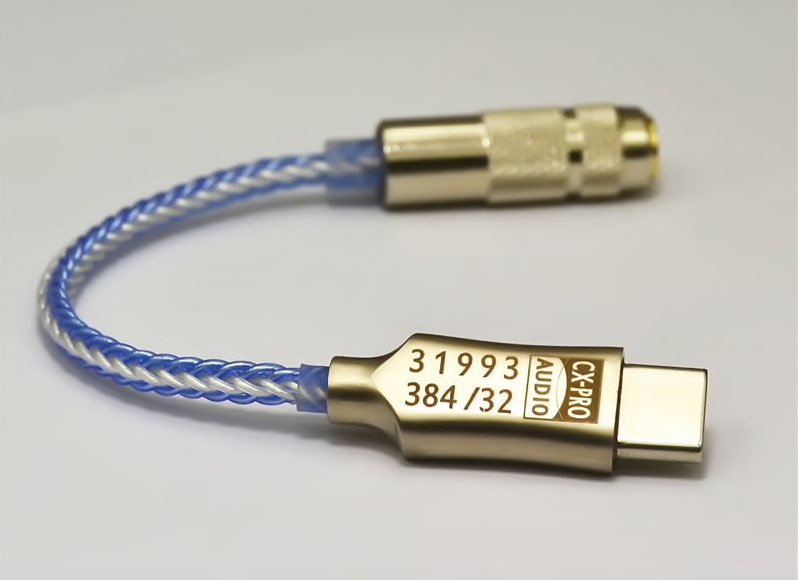I received the CX31993 now and have tried all three. The bottom line is they all work fine with freebsd 14.3. I tested them with my thinkpad X201 and Sennheiser HD560S headphones. Configuration consists of plugging it in, cat'ing /dev/sndstat to see which device number was assigned, and then setting that value to the hw.snd.default_unit sysctl.
In the photo below, the CX31993 is at the top, the JM20 is in the middle and the NICE-HCK is at the bottom.
A few observations.
Each unit consists of a USB-C plug containing the electronics, a multi-strand connecting cable (variously described as 'silver' or 'silver plated') and a floating 3.5 mm jack socket. There were claims that silver or silver-plated wire improves the sound quality... well, how much difference a couple of inches of silver wire will make when connected to about 1-2m of copper headphone cable, I really don't know.
They all have different strengths and weaknesses.
Connector build quality: the CX31993 looked the best, with high quality metal parts, then the JM20, then the NICE-HCK which appeared to have a slightly cheap-looking metallised plastic plug.
Cable build quality: all three had what are claimed to be silver multi-strand cables, with no overall outer casing. The JM20 cable looked the most robust and the CX31993 the most fragile. All three of the cables concerned me, they want to show off the silver wire, so they omit an overall jacket, however that leaves the cable strands vulnerable to damage. Memories of bending cables with broken cores to try to get a connection in the old days come to mind. The cable on the CX31993 in particular looked like it wouldnt stand up to much rough handling, in contrast to the high quality connectors they've used. I guess if the device is wired into a static system where the cable isn't moved around much it wouldn't matter. But if it's shoved in a pocket with some earbuds and pulled out and put back every time it's used, perhaps none of them are going to last very long. Of course once one of those delicate cores is broken there is really no way to repair the thing. They are all one-time assembly, there's no way to take them apart without destroying them, or not that I could see.
Accessories. The JM20 came with nothing, not even a USB C to A adapter, just a little cardboard box. The CX31993 came in a steel presentation tin with a USB C to A adapter; and the NICE-HCK came with a USB C-to-A adapter, two cloth carrying cases, and a set of spare rubber earbud earpieces in a carrying case, so you get a LOT of accessories with the NICE-HCK, and they might be useful for someone who uses earbuds.
Sound quality. All three are good, but I thought the JM20 sounded the best overall with my 120 ohm headphones. However that might not be a very fair test as I suspect these are mainly intended to be used with low-impedance earbuds. I got the impression the JM20's dac chip has the best headphone amplifier of the three, it seemed to have a bit more power than the other two; in fact the JM20 was the only one of the three that had as much drive power as the thinkpad's own audio output through the headphone socket. If I was chosing from them purely on sound quality, I would get the JM20 - with the proviso that I've only tested them on the HD560S's; the other two might well be great with lower impedance phones or earbuds.
Value for money. I paid 8 GBP for the CX31993, 13 pounds for the NICE-HCK and 15 pounds for the JM20. So the JM20 was almost twice the price of the CX31993, and it came with the least amount of accessories.
Noise and other artefacts: I didn't notce any audible sign of problems with fade-in, pops or clicks, hum, or anything else with any of them. All three of them worked fine.
Were any of them audibly significantly better than the thinkpad's own audio output through the headphone socket? Not much. The thinkpad has an older conexant sound chip, and I strongly suspect a separate dedicated headphone amp chip driving the headphone socket, since it has plenty of output power. The JM20 was perhaps slightly better than the thinkpad, although the differences are pretty small; and the other two usb dacs had less drive power than the thinkpad. It might be that if I had a pair of high-end 2000-GBP Focal headphones I might be able to hear a real difference, but with the HD560s the JM20 sounded just about the same as the thinkpad headphone socket. Which I was ever so slightly disappointed at. What differences there are, are very subtle. They both (thinkpad and JM20) sound pretty good to my ears. Doh, there goes my career as a golden-eared hifi reviewer...
Right, I'm off to get a hifi mains plug for my laptop mains adapter....


 www.audioreviews.org
www.audioreviews.org

 www.audioreviews.org
www.audioreviews.org




